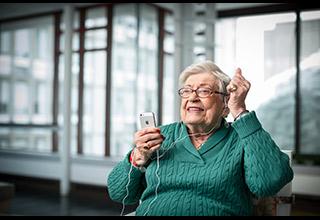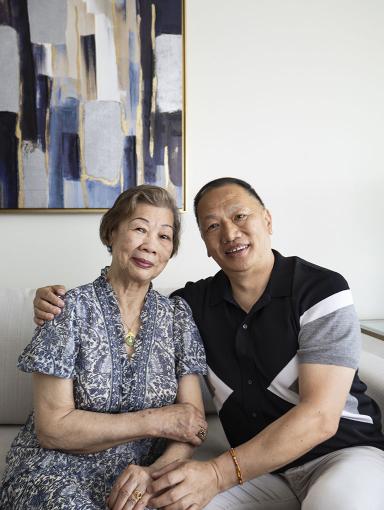Ten Years With Tamari: Reflecting on the Impact of Our Beloved Ministry Service Dog
“Tamari’s legacy is one of love and how a long-term chronic care community can integrate a dog into its patients’ day-to-day activities and lives.”

In 2015, we introduced Tamari, the remarkable service dog bringing healing and companionship to our patients and residents. Almost a decade later, she’s still forging unbreakable bonds with patients at Hebrew Rehabilitation Center at NewBridge on the Charles in Dedham, MA, and residents in independent and assisted living. Rabbi Karen Landy, manager of religious and spiritual care service and a chaplain at NewBridge on the Charles, reflects on Tamari’s years of service:
What is Tamari’s background?
I first learned about the organization that trained Tamari, NEADS World Class Service Dogs, in the wake of the Boston Marathon bombing. I read about how NEADS placed service dogs with some of the victims of the attack and learned how they trained ministry service dogs. I looked at their program, thinking a service dog would be amazing to have in my chaplaincy toolkit. I contacted them and went for an interview, and NEADS placed me with Tamari within a few months.
Before she was with me, Tamari was at the Massachusetts Correctional Institution at Concord. She was placed there when she was eight weeks old, training one-on-one with an inmate during the week and spending weekends with a foster family. I met Tamari when she was around a year old, training with her on the NEADS campus for a week and a half. We’ve been together ever since, and she’s now 11 and a half years old.
How has Tamari’s role evolved over the past decade, and are there any new ways she’s helping patients and residents?
When Tamari first arrived at Hebrew Rehabilitation Center, she was always on a leash with me, and I was very strict about her commands. Throughout the years, especially on the floor my office is on, she’s started to roam a lot more. I’ve loosened her leash and allowed her to create her own relationships with patients, which has been highly effective.
She’s still on a leash doing one-on-one visits for most of the day, but the rest of the time, she’s not on a leash. She walks into different households, and some patients have figured out that if they keep snacks in their room, she’ll come to visit them. She also has her afternoon nap with a few people.
Can you share any memorable or touching moments from her years of service?
Naps with Tamari are powerful for people. There are times when I will go into a patient’s room, and they’re sleeping on a recliner, and Tamari’s on their bed — and that means they’ve told her to get on the bed because she typically will only do that if they give the command.
She’s also extremely sensitive when people are at the end of life. There was one person who Tamari was very, very, very close to. I brought Tamari to the church funeral service, and she went up to their coffin and spent the entire service in front of it.
Are there any special routines or traditions that have developed around Tamari’s presence?
More than anything, what stands out is the number of patients and staff — probably close to 20 — who now have treats for Tamari in their rooms and offices. She knows exactly where those rooms and offices are, and she makes rounds every single day.
I try to give Tamari only healthy food, and some patients know that. So I have one woman who, whenever there are carrots or broccoli, saves them in the refrigerator for Tamari and gives them to her the next day. She’ll come into my office and ask if Tamari is hungry. That’s one of the rituals people have created, and it’s really sweet. They love her.
I also dress her up a few days a year, such as Halloween, Veterans Day, the Fourth of July, and the Jewish holiday of Purim. People love seeing her in either a dog costume or a t-shirt.
Have there been any changes in the type of support Tamari provides as she ages?
Something Tamari used to do a lot is fetching. If someone had physical therapy and threw a ball, Tamari would retrieve it so they could throw it again. While Tamari still fetches, she fetches a bit less than she used to. It also depends on people’s needs, so she now offers more one-on-one comfort than doing activities with people.
But she’s still very active. When the weather is nice, I use her to get people to go outside and go for walks. I’ll ask people if they want to take her for a walk, and I can hook her leash to a wheelchair so they feel like they’re actually walking her. Generally speaking, Tamari has continued doing the same activities, and she’s aged in place very well.
How has Tamari’s long-term relationship with the community impacted her and the people she serves?
For Tamari, she has had a great life. I don’t know if there is a dog that is more loved than Tamari. A lot of patients were dog people. Even if they weren’t, there’s a way that she fulfills this desire they have to nurture another being, whether that’s through offering her a treat or just petting her.
People have authentic relationships with Tamari. For patients with a relationship with her, it’s about joy. Dogs don’t judge or hurt you in any way. Everyone here knows who she is. Even patients with significant dementia who may not remember my name have asked me where the dog is if she isn’t with me. It’s an amazing connection.
She even helps visiting family members. When family members bring younger generations here who may be nervous about visiting a long-term chronic care community or a loved one near the end of life, I’ll bring Tamari in. She offers a meditative presence and allows them to focus on her, which then causes many people to speak more freely to me as they pet her.
How has your connection with Tamari deepened over time?
She’s my best buddy. I’ve always had at least one to three dogs at any given moment, and I just spend so much time with her. She’s part of my work and part of my life. I think a lot about how I’ve done chaplaincy for over 30 years, and she was probably one of my best ideas. She helps the community so much, and I didn’t realize how much I also needed her companionship.
Does Tamari have any dog siblings at home with her right now?
She does! My five-year-old rescue terrier, Maisie, has the same routine every day. She runs to the door and wags her tail like she’s been waiting for Tamari to come home all day. She’s so excited to see her. They play for half an hour, then Tamari gets to relax. They’re good buddies.
What will Tamari’s legacy be at Hebrew SeniorLife?
Tamari is probably the most beloved staff member — and not only at Hebrew Rehabilitation Center. We also do one-on-ones with assisted and independent living residents. Everyone loves her! Tamari’s legacy is one of love and how a long-term chronic care community can integrate a dog into its patients’ day-to-day activities and lives. And that’s powerful.
Join Our Community: Subscribe to the Hebrew SeniorLife blog for weekly insights on healthy aging and senior living.
Blog Topics
Learn More
Long-Term Chronic Care
Hebrew Rehabilitation Center provides person-centered extended medical care in a homelike setting for patients with chronic illness. As a licensed long-term chronic care hospital, we provide higher-level, more comprehensive medical care to older adults than a traditional nursing home.





